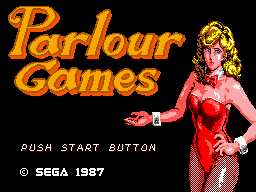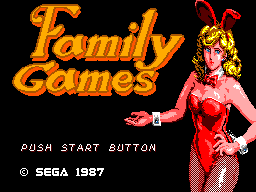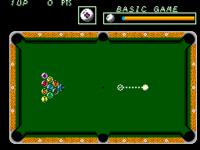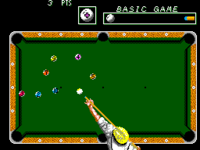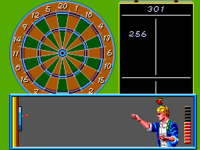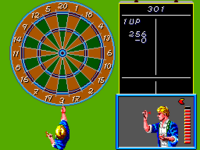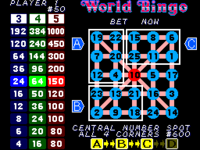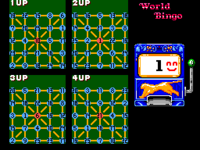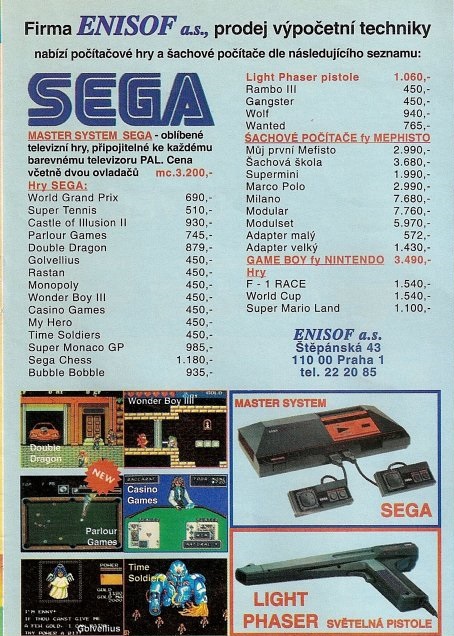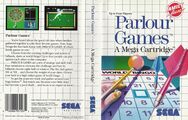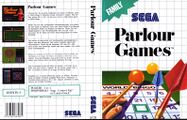Parlour Games
From Sega Retro
| ||||||||||||||||||||||||||||||||||||||||||||
| Parlour Games | ||||||||||||||||||||||||||||||||||||||||||||
|---|---|---|---|---|---|---|---|---|---|---|---|---|---|---|---|---|---|---|---|---|---|---|---|---|---|---|---|---|---|---|---|---|---|---|---|---|---|---|---|---|---|---|---|---|
| System(s): Sega Master System, Sega Mega-Tech | ||||||||||||||||||||||||||||||||||||||||||||
| Publisher: Sega Enterprises, Ltd. (JP, EU), Sega of America (US) | ||||||||||||||||||||||||||||||||||||||||||||
| Developer: Compile | ||||||||||||||||||||||||||||||||||||||||||||
| Distributor: Tonka (US)
Samsung (KR) | ||||||||||||||||||||||||||||||||||||||||||||
| Peripherals supported: FM Sound Unit | ||||||||||||||||||||||||||||||||||||||||||||
| Genre: Other[1], Family[2] | ||||||||||||||||||||||||||||||||||||||||||||
| Number of players: 1-4 | ||||||||||||||||||||||||||||||||||||||||||||
|
Parlour Games, known as Family Games (ファミリー・ゲームズ) in Japan, is a Sega Master System game.
Contents
Gameplay
The game is a collection of three simple multiplayer games.
In all games, ![]() confirms selections and
confirms selections and ![]() cancels or goes back.
cancels or goes back.
All multiplayer games are alternating (taking turns). Players 1 and 2 use separate control pads. Player 3 shares a control pad with player 1, and player 4 shares a control pad with player 4.
Billiards
A pool mode with four different games. In every game, players use a cue stick to knock a white cue ball into the colored object balls, with the goal of sinking the object balls into one of the six pockets on the table. Balls bounce off each other and the sides of the table, which can be used to set up shots. Scratching (pocketing the cue ball) is a foul, which results in the next player being able to place the cue ball anywhere on or behind the foot string (the rightmost quarter of the table). Every game starts with a break, where the object balls are racked into a group and the first player shoots the cue ball into them to break them up. The number of each ball is shown when it is not in motion.
When playing against an AI opponent, there are two difficulty levels (Amateur and Professional). Computer players have a delay where they must "think" before making a shot.
When making a shot, an image line appears that shows the direction of the cue ball after it is hit. The line can be rotated with ![]() and
and ![]() (which aims the shot) or extended with
(which aims the shot) or extended with ![]() and
and ![]() (which helps illustrate the trajectory but does not affect the shot).
(which helps illustrate the trajectory but does not affect the shot).
After confirming the aim, the player can change the strike point on the ball using the D-Pad. Hitting the ball high adds top spin (which causes the cue ball to follow the object ball after hitting it), hitting the ball low adds draw (which causes the cue ball to roll back after hitting the object ball), while hitting it dead center brings the cue ball to a stop after hitting the object ball. Hitting the ball on the either side causes the cue ball to rebound toward that side after hitting the object ball.
At the same time as the strike point selection, a cue stick moves back and forth to show the strength of the shot. The player can stop the meter at any point; closer to the cue ball is a lighter shot, and further from the cue ball is a harder shot.
Basic Game
A straight pool game (but without the necessity of calling the next shot before making it) played with ten balls. Each player tries to earn the highest score by pocketing as many balls as possible. Each pocketed ball is worth one point, and the game is played up to a certain number of points (10 by default, but it can be set to any number from 1 to 200). It can be played by one to four players. Single-player games can be played alone (non-competitively) or against an AI opponent.
Players take turns making shots. A player's turn continues until the player fails to pocket a colored ball or scratches.
Nine Ball
The object of the game is to sink all of the object balls in order. There are nine balls, and whichever player pockets the 9-ball wins the game. It can be played by one to four players. Single-player games can be played alone (non-competitively) or against an AI opponent. Games can be played up to a certain number of sets (1 by default, but it can be set to any number from 1 to 21), a set being a complete game from the break shot to sinking the 9-ball.
Players take turns making shots. A player's turn continues until the player commits a foul. Failing to pocket a legal ball or pocketing the cue ball are both fouls. It is not illegal to pocket balls other than the lowest ball on the table so long as the player touches the lowest ball with the cue ball first. When a player fouls, the next player can choose whether replace the cue or the object ball.
Five Ball
This game is played with nine balls. Eight of the balls are divided into two groups, the Low Side (balls 1 through 4) and the High Side (balls 6 through 9). Each player is assigned one group of balls (before starting the game) and must pocket those balls (in any order). After doing so, the player pockets the 5-ball to win. It can be played by one or two players. Single-player games are always played against an AI opponent. Games can be played up to a certain number of sets (1 by default, but it can be set to any number from 1 to 21), a set being a complete game from the break shot to sinking the 5-ball.
Players take turns making shots. A player's turn continues as long as the player continues pocketing assigned balls and does not scratch. Pocketing an opponent's ball before pocketing one's own ball ends the player's turn (though pocketing an opponent's ball after pocketing one's own ball is allowed). Pocketing the 5-ball early is a foul and returns the 5-ball back to the head spot (the leftmost dot on the table).
Rotation
The object of the game is to sink all of the object balls in order. There are ten balls, and each awards the number of points on the ball (so the 1-ball is worth one point, but the 10-ball is worth ten points). The game is played up to a certain number of points (28 by default, but it can be set to any number from 1 to 200). It can be played by one to four players. Single-player games can be played alone (non-competitively) or against an AI opponent.
Players take turns making shots. A player's turn continues until the player commits a foul. Failing to pocket a legal ball or pocketing the cue ball are both fouls. It is not illegal to pocket balls other than the lowest ball on the table so long as the player touches the lowest ball with the cue ball first. The player receives points for any balls legally pocketed. When a player fouls, any balls sunk on that shot are returned to the table.
Darts
A darts mode with four different games. In every game, players throw three darts per turn at a dart board. The board is divided radially into multiple slices with different point values (shown on the outermost ring). The board is further divided concentrically into multiple zones that affect scoring: the outermost ring (with the numbers on it) awards no points, the double-score ring (the larger red/blue ring) awards double points, the triple-score ring (the smaller red/blue ring) awards triple points, and the single-score rings (the green/brown sections) award normal points. The bullseye is in the center (which is worth 25 points for the blue outer ring and 50 points for the red center). When the player throws a dart somewhere on the board, the point value is taken from the value of the slice multiplied by the ring where it landed. The highest possible value for a single throw is 60 points for a dart landed in the triple-score ring of the 20-point slice (thus the highest possible value for a turn is 180 points).
All games can be played by one to four players. Single-player games can be played alone (non-competitively) or against an AI opponent. When playing against an AI opponent, there are two difficulty levels (Amateur and Professional). Players can choose the weight of their darts (Light, Middle, or Heavy). This choice is a matter of personal preference; lighter darts require more force to throw.
When throwing a dart, the player can position the dart thrower with ![]() and
and ![]() . Then the player must hold
. Then the player must hold ![]() to fill the red power meter, which determines the strength of the throw. The meter fills and empties repeatedly if the player continues to hold
to fill the red power meter, which determines the strength of the throw. The meter fills and empties repeatedly if the player continues to hold ![]() . If the throw is not strong enough, the dart does not stick to the board. After releasing
. If the throw is not strong enough, the dart does not stick to the board. After releasing ![]() , the player must quickly press
, the player must quickly press ![]() again to decide the release point of the throw. This determines the height of the throw. Releasing too early or too late results in missing the board.
again to decide the release point of the throw. This determines the height of the throw. Releasing too early or too late results in missing the board.
301 and 501
301 and 501 are separate games with the same rules. Each player starts with a score of 301 or 501 points (depending on the game), and earning points reduces the score. Players get three throws per turn, and the first player to reach zero points wins. The player must reach zero points exactly; dropping below zero is a "bust," and the throw is discarded (returning the player to the score from before the throw was made).
The games have the following options for the first and last darts:
- Open In, Open Out: The first and last darts can land anywhere legally.
- Open In, Double Out: The first dart can land anywhere legally. The game can only be ended by a player landing the last dart on a double ring to zero out (otherwise the throw is discarded, same as a bust).
- Double In, Double Out: The first and last darts of the game must both hit double rings to count.
Round the Clock
The object of this game is to throw the darts into the numbered areas from 1 to 10 in order. Each player has three throws per turn to land a dart in the correct numbered area. If the player succeeds, the player receives a mark next to that number on the scorecard and can throw for the next number. If a number is hit out of sequence, the player receives no mark and can keep throwing until the end of the turn. Landing in the double or triple rings counts as the same value as landing in the other areas.
Double Down
The rules of the game are to hit the designated areas (shown in the scorecard on the right) in order. Each player starts the game with 40 points and earns points for each dart successfully landed in the correct area (with the double and triple rings awarding double and triple points). The player gets three throws for each area. If the player fails to land in the correct area for all three throws, the player's score is halved. Either way, the player proceeds to the next number after completing all three throws. Most of the areas are numbered slices, but there is one round for landing anywhere in the double ring ("D") and one round for landing anywhere in the triple ring ("T"), and the last round must hit the bullseye ("B"). The player with the highest score at the end of all nine rounds wins the game.
World Bingo
This is a gambling game. One to four players can play. Players can choose to play from 1 to 20 games. The bingo card on the right side of the screen contains 25 balls arranged in a 5 by 5 grid, marked with numbers from 1 to 25. Players spin a slot machine to get a number. The balls on the card are blue initially but turn red when they are won on the slot machine. The goal of the game is to be the first player to have five red balls in a row (vertically, horizontally, or diagonally) by winning them on the slot machine.
The bingo card is divided into four segments consisting of six balls each (omitting the center ball), called the "feature blocks" are marked with A, B, C, and D blocks on the bottom of the screen. These blocks light up as the player's bet is increased (at randomized thresholds). Increasing the bet may also cause the statements "ALL 4 CORNERS $300 ($600)" or "ANY 3 CORNERS $600" to appear, which indicates that winning numbers in any three or all four corners wins the money shown. Increasing the bet also turns the center ball red at some point ("winning" it for the player automatically).
The left side of the screen shows the dividends paid for making three-in-a-row ("3"), four-in-a-row ("4"), or five-in-a-row ("5"). These are additional winnings made if the player wins three, four, or five numbers from the slot machine in a row. The highlighted row shows the current dividend (payoff), which increases as the player's bet increases.
Each player starts with $100 and can bet any amount from $1 and up. Before the first spin is taken, each player can choose a different bingo card (with the numbers arranged differently) using the D-Pad. At the start of a round, pressing ![]() increases the bet by $1. The player enters the bet by pressing
increases the bet by $1. The player enters the bet by pressing ![]() , which changes the screen to the slot machine view (which shows the bingo cards for all four players simultaneously). Then the player spins the slot machine by pressing
, which changes the screen to the slot machine view (which shows the bingo cards for all four players simultaneously). Then the player spins the slot machine by pressing ![]() . When the slot machine stops spinning, it shows a number with either a smiling face or a frowning face, depending on whether the player won a number on their bingo card or not. If the player gets a frowning face, the player can continuing spinning.
. When the slot machine stops spinning, it shows a number with either a smiling face or a frowning face, depending on whether the player won a number on their bingo card or not. If the player gets a frowning face, the player can continuing spinning.
After winning a number, the player returns to the betting screen and can rearrange the feature blocks (with ![]() for the A block,
for the A block, ![]() for the B block,
for the B block, ![]() for the C block, and
for the C block, and ![]() for the D block) up to three times.
for the D block) up to three times.
A player "busts" after losing all of their money.
History
During development, the game was known under the working title of Party Games.[5]
Versions
Localised names
| Language | Localised Name | English Translation |
|---|---|---|
| English | Parlour Games | Parlour Games |
| English (US) | Parlour Games | Parlour Games |
| Japanese | ファミリー・ゲームズ | Family Games |
Magazine articles
- Main article: Parlour Games/Magazine articles.
Promotional material
Physical scans
Master System version
| Sega Retro Average | ||||||||||||||||||||||||||||||||||||||||||||||||||||||||||||||||
|---|---|---|---|---|---|---|---|---|---|---|---|---|---|---|---|---|---|---|---|---|---|---|---|---|---|---|---|---|---|---|---|---|---|---|---|---|---|---|---|---|---|---|---|---|---|---|---|---|---|---|---|---|---|---|---|---|---|---|---|---|---|---|---|---|
|
| 58 | |
|---|---|
| Based on 12 reviews | |
| Master System, BX† |
|---|
|
Mega-Tech version
Technical information
ROM dump status
| System | Hash | Size | Build Date | Source | Comments | |||||||||
|---|---|---|---|---|---|---|---|---|---|---|---|---|---|---|
| ? |
|
128kB | Cartridge (EU/US) | |||||||||||
| ? |
|
128kB | Cartridge (JP) |
References
- ↑ 1.0 1.1 https://sega.jp/history/hard/segamark3/software.html (Wayback Machine: 2020-11-14 21:32)
- ↑ File:ParlourGames SMS EU Box.jpg
- ↑ Computer Entertainer, "May 1988" (US; 1988-05-14), page 09
- ↑ Raze, "September 1991" (UK; 1991-07-25), page 76
- ↑ http://www.smspower.org/forums/6961-JapaneseMagazineSegaSpecialIssue198711UnreleasedSegaMarkIIIGames (Wayback Machine: 2016-04-06 08:54)
- ↑ Complete Guide to Consoles, "Volume IV" (UK; 1990-11-xx), page 103
- ↑ The Complete Guide to Sega, "" (UK; 1991-05-xx), page 59
- ↑ Console XS, "June/July 1992" (UK; 1992-04-23), page 143
- ↑ Joystick, "Décembre 1990" (FR; 1990-1x-xx), page 125
- ↑ Mean Machines Sega, "October 1992" (UK; 1992-09-xx), page 135
- ↑ Player One, "Décembre 1990" (FR; 1990-xx-xx), page 54
- ↑ Power Play, "11/88" (DE; 1988-10-10), page 53
- ↑ Power Play, "8/90" (DE; 1990-07-13), page 127
- ↑ Sega Power, "October 1991" (UK; 1991-09-05), page 58
- ↑ Sega Pro, "March 1992" (UK; 1992-02-20), page 20
- ↑ Sega Pro, "April 1993" (UK; 1993-03-11), page 71
- ↑ Supergame, "Julho 1992" (BR; 1992-07-xx), page 18
| Parlour Games | |
|---|---|
|
Main page | Comparisons | Hidden content | Magazine articles | Reception | |
- FM Sound Unit-compatible games
- 1-4 player games
- JP Master System games
- All JP games
- US Master System games
- All US games
- EU Master System games
- All EU games
- BX Master System games
- All BX games
- UK Master System games
- All UK games
- AU Master System games
- All AU games
- KR Master System games
- All KR games
- Master System games
- 1987 Master System games
- All 1987 games
- Master System table games
- All table games
- All arcade games
- Mega-Tech games
- Unknown year games
- All games
- Old technical information
- Parlour Games
